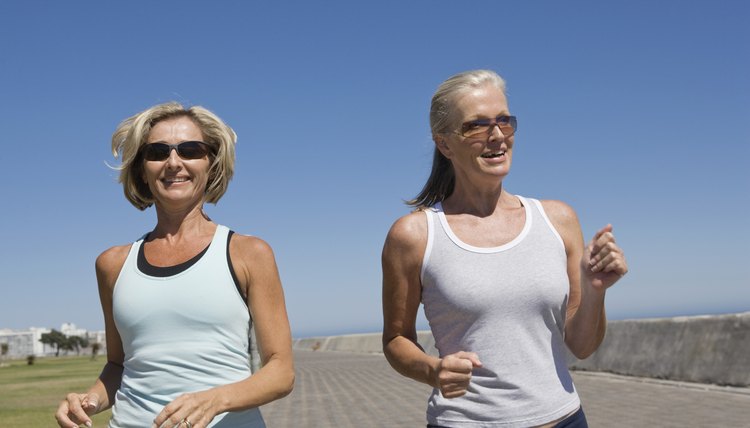Detriments of Jogging After 50

Jogging provides an effective workout for your heart and your muscles. Jogging may be more difficult after age 50, however, since your knees, back, hips, ankles and feet will have suffered more than half a century of wear and tear. Many people who were joggers or runners most of their lives turn to other sports that are less stressful on the joints, such as bicycling and swimming. If you want to jog at age 50 or older, you can minimize the detriments to your body by taking some reasonable precautions.
Knee Considerations
The old saying that "the knees are the first to go" isn't that far from the truth, especially if you are overweight or have had a knee injury, particularly one that required surgery. Both those issues can contribute to the onset of osteoarthritis, an inflammation of the joints due to wear and tear. Jogging can actually speed up progression of arthritis in the knees if those joints are already vulnerable. If, however, you maintain a healthy weight, wear running shoes that offer support and flexibility, and stick with flat surfaces, you may find that jogging's benefits outweigh risks to the knees.
Jogging and Your Feet
Your feet take quite a pounding when jogging, too. A 10-mile jog can equate to 15,000 impacts between your feet and the ground at a force that's three to four times your body's weight. If you haven't seen a podiatrist and you jog frequently, you should make an appointment, even if you have no pain or symptoms. For example, identifying early signs of wear and tear on the plantar fascia, the thick band of tissue that runs along the bottom of the foot, can save you pain later on. Your doctor may prescribe orthotic devices for your running shoes to improve arch support and slow the progression of any chronic foot problems.
Getting Overheated
As you get older, you gradually lose your ability to sweat and you may find it more difficult to tell when you are starting to get overheated. Compounding the problem is that increasing age also results a decreasing sense of thirst. You may be starting to become dehydrated without even starting to feel thirsty. For these reasons, jogging, especially outdoors in the heat, can be especially dangerous for older adults. To stay safe while jogging, try to avoid activity during the hottest parts of the day and be sure to stay hydrated before, during and after you jog. While jogging or doing any exercise, try to drink at least 8 oz. of water for every hour you're active.
Neck and Back Pain
Nearly half of all older adults will experience lower back pain of some kind. Neck pain is also a common age-related condition. Both can be exacerbated by jogging, especially if you don't follow proper form. If you have back or neck pain, try to minimize your time jogging up and down hills. Jogging downhill, for example, causes many joggers to overcompensate and lean back farther than they should, putting excess strain on their backs. Looking down too much while jogging can also strain the neck. Keeping your head and gaze level and your back as straight as possible can help you avoid some unnecessary discomfort from jogging at any age.
References
Writer Bio
James Roland started writing professionally in 1987. A former reporter and editor with the "Sarasota Herald-Tribune," he currently oversees such publications as the "Cleveland Clinic Heart Advisor" and UCLA's "Healthy Years." Roland earned his Bachelor of Science in journalism from the University of Oregon.
